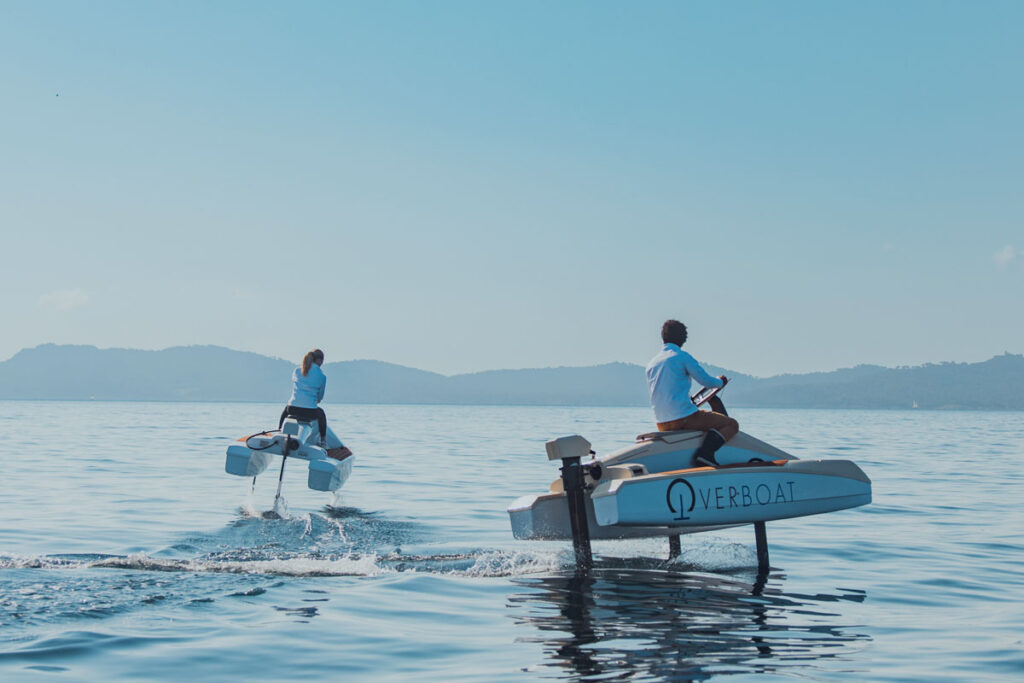[LUM#17] A technological wave to protect the deep blue sea
Faced with an overexploited Mediterranean, scientists are looking for ways to reduce the impact of human activities on marine environments. Technological solutions include the Donia mobile application to encourage boaters to protect seagrass beds, and the Overboat, an electric jet ski.

Oceanographers and marine biologists are on deck. Anxious to study environments while witnessing their destruction, they are combining their ecological knowledge with the technological wind blowing through the sciences to imagine solutions and develop products for the general public. The Donia navigation application, for example, is designed to help boaters protect sensitive marine ecosystems. " The idea for this application came from our work on the protection of posidonia, a protected species that continues to disappear due to boat anchoring", explains Julie Deter, a teacher-researcher at the Marine Biodiversity, Exploitation and Conservation Laboratory (Marbec*) and project manager at Andromède océanologie, a marine ecology consultancy.
Between 2011 and 2018, a quarter of Posidonia meadows disappeared due to anchoring in the bay of Golfe-Juan, despite the ban on destroying this protected marine habitat. "The ban is ineffective because the police power only applies if the destruction is voluntary. But it's impossible to determine whether or not a yachtsman has knowingly dropped his anchor in a seagrass bed", says Julie Deter. By offering simplified maps of marine habitats down to a depth of 50 meters, Donia not only raises awareness among boaters, but also provides them with information on marine regulations. These maps are based on the fine, continuous mapping of Mediterranean coastal marine habitats between 0 and 80 meters published in 2014.
Oceanology in your smartphone
Launched in 2013 by Andromède, the application won the Entreprises & Environnement award. It now has 33,000 active users. To attract the less ecologically-minded among them, several functions have been provided: practical information for easy anchoring, weather, marine maps and points of interest such as diving sites or underwater trails. " Another argument is that it's a community app that lets you share cool anchorages, dive spots, marine wildlife sightings and floating hazards," defends Julie Deter, who sees Donia as "a waze for the sea".
But for the ecologist, the challenge is also to better control anchorages. Mission accomplished for boats over 24 metres, which must be fitted with a beacon to identify and locate them. "Our team worked with the Agence de l'eau Rhône Méditerranée-Corse, the Préfecture maritime and the customs authorities to change the regulations. There is now a firm ban on anchoring in meadows for boats over 24 metres in length", says the researcher. For the others, in the absence of beacons, it is still difficult to tighten controls, even though they represent 95% of the boats that anchor on the coast. To better assess their ecological impact on the meadows, research has just been launched atIntosea, the joint laboratory uniting the University of Montpellier and Andromède Océanologie.
Still faced with the imperative of mitigating the impacts of human activities, in 2016 oceanographer Vincent Dufour imagined the Overboat, a small electric boat that saw the light of day in 2019. Looking like a jet ski of the future, this single- or two-seater moves with a foil, thanks to electric batteries. Vincent Dufour defends his creation: "Not only is it a new way of getting around on the water, but above all, you don't need to be a crack sailor, since the boat's intelligence will manage everything for you." Numerous technologies are in fact on board: "computers constantly process information on the boat's position to ensure its balance", explains Frédérique Bos, Neocean's sales director. This company was created ad hoc by Vincent Dufour to develop the Overboat.
Carbon footprint
In terms of marine ecology, the Overboat's electric motor is silent, and the boat's low wake reduces erosion damage to riverbanks. Above all, the Overboat's foil reduces friction, considerably reducing the energy required for propulsion: "the foil divides energy consumption by four", points out Frédérique Bos. To prove this reduced ecological footprint, Neocean has compared CO2 emissions with a jet ski, taking into account construction and three years of use: while the Overboat does less well during construction because of the batteries, after three years its carbon footprint is 2,600 kg CO2 equivalent, compared with 38,000 kg CO2 equivalent for the jet ski.
But why go electric when sailing is the most eco-friendly means of transport ? It's not the same use! The Overboat is of interest to port and marine park operators, for example, who need to navigate between boats and dock easily. It's also a hit with water sports centres, where noise and pollution are becoming a concern, and people are looking for less impactful leisure activities", explains Frédérique Bos. The Overboat has already won over some thirty customers in France, Spain, Italy and Holland. The purchase price is still around 30,000 euros.
UM podcasts are now available on your favorite platforms (Spotify, Deezer, Apple podcasts, Amazon Music...).
*Marbec (UM, IRD, CNRS, Ifremer)